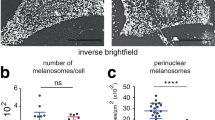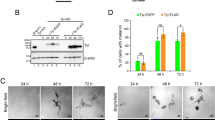Abstract
DURING his classical investigations of intracellular organelles Claude isolated melanin granules from the liver of Amphiuma tridactylum1. Sections of these granules were later examined by Drochmans, who showed them to possess definite structural detail2. Other investigations have shown the existence of a highly regular, almost crystalline lattice in melanin granules from other tissues3. Melanin itself was suggested by Longuet-Higgins as having properties of a one-dimensional semi-conductor4, and this was agreed on by Pullman5. Semiquinone free radicals have been demonstrated in melanin granules and the characteristic signals6 became more pronounced during irradiation of such granules with light7,8.
This is a preview of subscription content, access via your institution
Access options
Subscribe to this journal
Receive 51 print issues and online access
$199.00 per year
only $3.90 per issue
Buy this article
- Purchase on Springer Link
- Instant access to full article PDF
Prices may be subject to local taxes which are calculated during checkout
Similar content being viewed by others
References
Claude, A., Harvey Lectures, 93, 121 (1948).
Drochmans, P., Intern. Rev. Exp. Pathol., 2, 357 (1963).
Drochmans, P., J. Biophys. and Biochem. Cytol., 8, 165 (1960).
Longuet-Higgins, H. C., Arch. Biochem. Biophys., 86, 231 (1960).
Pullman, A., and Pullman, B., Biochim. Biophys. Acta, 54, 384 (1961).
Commoner, B., Townsend, J., and Pake, G. E., Nature, 174, 689 (1954).
Mason, H. S., Ingram, D. J. E., and Allen, B., Arch. Biochem. Biophys., 86, 225 (1960).
Cope, F. W., Sever, R. J., and Polis, B. D., Arch. Biochem. Biophys., 100, 171 (1963).
Dorner, M., and Reich, E., Biochim. Biophys. Acta, 48, 534 (1961).
Du Buy, H. G., Showacre, J. L., and Hesselbach, M. L., Ann. N.Y. Acad. Sci., 100, 569 (1963).
Cotzias, G. C., Papavasiliou, P. S., and Miller, S. T., Nature, 201, 1228 (1964).
Cotzias, G. C., Papavasiliou, P. S., Van Woert, M. H., and Sakamoto, A., Fed. Proc., 23, 713 (1964).
Charles, A., and Ingram, J. T., J. Biophys. and Biochem. Cytol., 6, 41 (1959).
Wellings, S. R., and Seigel, B. V., J. Nat. Canc. Res., 24, 437 (1960).
Weissenfels, N., Z. Zellforsch., 45, 60 (1956).
Vogel, F. S., and McGregor, D. H., Lab. Invest., 13, 767 (1964).
D'Agostino, A. J., and Luse, S. A., Neurology, 14, 529 (1964).
Staubli, N., and Loustalot, P., Cancer Res., 22, 84 (1962).
Author information
Authors and Affiliations
Rights and permissions
About this article
Cite this article
PRASAD, K., JOHNSON, H. & COTZIAS, G. A Cytoplasmic Organelle of Melanocytes. Nature 205, 525–526 (1965). https://doi.org/10.1038/205525a0
Published:
Issue Date:
DOI: https://doi.org/10.1038/205525a0
This article is cited by
-
Polymelanosomes of the Melanocyte and their Substructures
Nature (1968)
-
Extension of the Concept “Vertebrate Epidermal Melanin Unit” to embrace Visceral Pigmentation and Leucocytic Melanin Transport
Nature (1967)
-
Funtional Similarities between the Cytoplasmic Organelles of Melanocytes and the Mitochondria of Hepatocytes
Nature (1965)
Comments
By submitting a comment you agree to abide by our Terms and Community Guidelines. If you find something abusive or that does not comply with our terms or guidelines please flag it as inappropriate.



